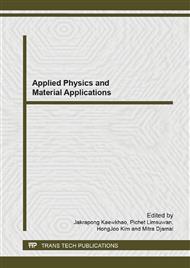p.173
p.177
p.181
p.185
p.189
p.193
p.197
p.201
p.205
Fabrication and Characterization of Tin Oxide Nanorods Prepared by Glancing Angle DC Reactive Magnetron Sputtering
Abstract:
In this work, we report the fabrication of tin oxide (SnO2) nanorods on (100) silicon substrate by glancing angle deposition (GLAD) technique with DC magnetron sputtering system and study the effect of oxygen flow rate on SnO2 nanorod growth. The crystal structure and morphology of SnO2 nanorod were characterized by x-ray diffraction and field-emission scanning electron microscopy. It was found that the structure of SnO2 nanorods changes from amorphous to crystalline as the oxygen flow rate increases from 12 to 24 sccm and the degree of crystallinity tends to improve as the oxygen flow rate increases further. From morphological characterization, all SnO2 films prepared with different oxygen flow rates comprise isolated columnar nanorod structures and the nanorod size tends to decrease as the oxygen flow rate increases. In addition, the deposition rate is found to decrease from 0.28 to 0.10 nm/s as the oxygen flow rate increases from 12 to 48 sccm.
Info:
Periodical:
Pages:
189-192
Citation:
Online since:
September 2013
Authors:
Price:
Сopyright:
© 2013 Trans Tech Publications Ltd. All Rights Reserved
Share:
Citation:


